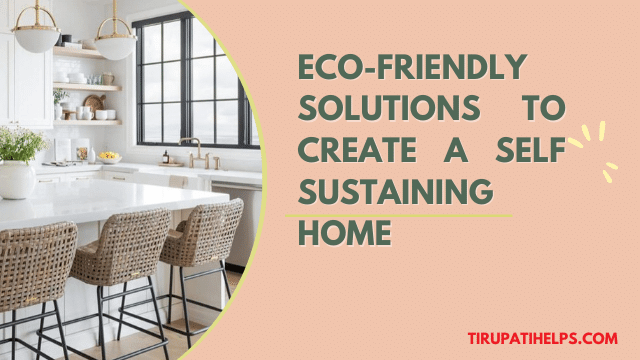Is reducing energy and water consumption important to you? Do you want to contribute to saving the world and organisms as a whole?
You need to hone in on using eco-friendly sustainability measures. You must use techniques and practices that are safe and kind to the world we inhabit.
You might be wondering how to start your venture. There are tons of things you can do. Read on to learn about several eco-friendly solutions to create a self sustaining home.
Green Building Materials
The materials used in building and renovating homes have a significant impact on the environment. Traditional building materials contribute to carbon emissions and deplete natural resources.
To make your home more sustainable, consider using green building materials. These are such as
- bamboo
- reclaimed wood
- recycled plastics
These materials are renewable, non-toxic, and have a lower carbon footprint compared to traditional building materials.
Renewable Energy Sources
One of the most effective ways to create a self-sustaining home is by utilizing renewable energy sources such as solar power, wind power, and geothermal energy. Solar panels can be installed on your roof or in your yard to generate electricity for your home. Make sure to read about cleaning solar panels to maximize it’s benefits.
You can also install a wind turbine if you live in an area with strong winds. Geothermal energy uses the heat from the earth to provide heating and cooling for your home.
Water Conservation
Water is a precious resource, and conserving it is essential for creating a self-sustaining home. Start by fixing any leaks in your plumbing and installing low-flow fixtures to reduce water usage. You can also collect rainwater in barrels or tanks to use for watering your plants and garden.
Another option is to install greywater systems that recycle wastewater from sinks, showers, and washing machines for outdoor use. These simple steps can help you reduce your water consumption and make your home more self-sufficient.
Zero-Waste Practices
Living a zero-waste lifestyle is becoming increasingly popular as people become more aware of the environmental impact of waste. To create a self-sustaining home, incorporate zero-waste practices such as composting, recycling, and using reusable products. Composting turns food scraps into nutrient-rich soil for your garden.
Recycling reduces the amount of waste that ends up in landfills. And using reusable products such as cloth bags, water bottles, and food containers helps reduce single-use plastics. These small changes can make a big difference in creating an eco-friendly and self-sustaining home.
Self-Sufficient Living Ideas
Aside from the above solutions, there are various other ways to make your home self-sufficient. For example, you can start a vegetable garden in your backyard to grow your produce. This not only reduces your carbon footprint but also promotes healthy eating habits.
You can also install a greywater system that recycles water from your sinks and showers for flushing toilets or watering plants. Additionally, consider using energy-efficient appliances and LED lighting to reduce energy consumption in your home.
Start Your Journey to Self Sustaining Home Today
In conclusion, implementing eco-friendly solutions to create a self sustaining home is not only beneficial for the environment but also for our wallets in the long run. These tips can help in the journey. Start by making small changes in your own home and encourage others to do the same.
Let’s work together to create a greener and healthier world for future generations. Join the movement and start making your home self-sustaining today!
If you want to read more articles, visit our blog.

Leave A Comment